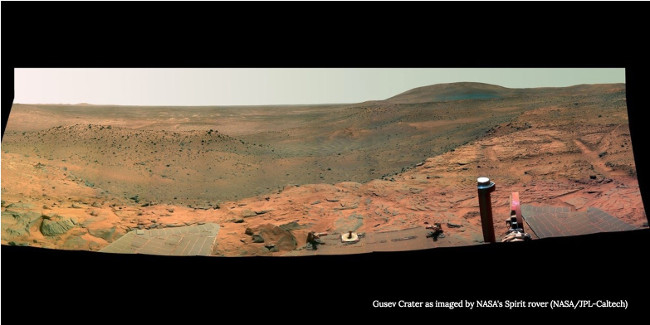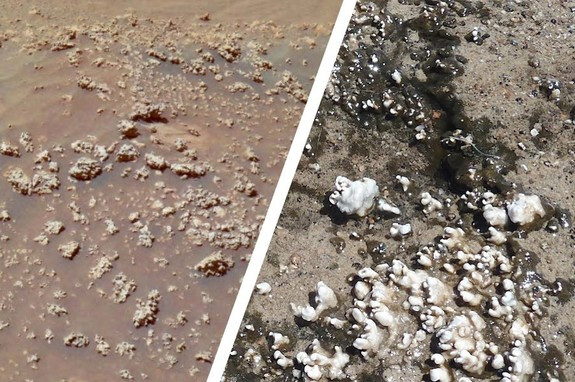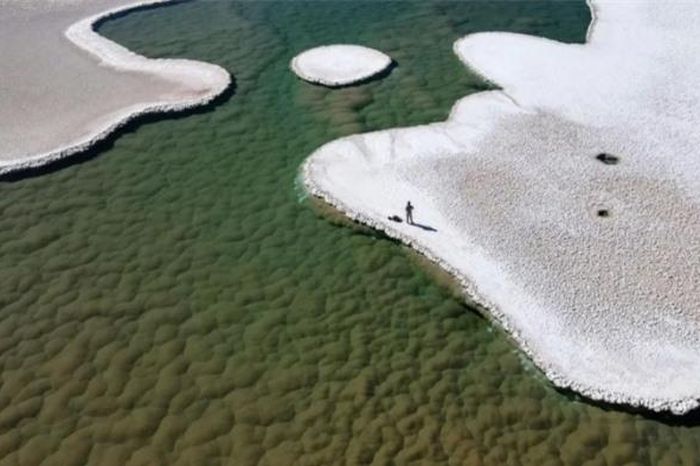Reveal the best place to find life on Mars
NASA's Spirit self-propelled robot has found evidence of life on Mars before being trapped in a sand pit and confirmed to disappear by NASA in 2010? It can be said that two geographers have identified a position on Earth formed by microorganisms that closely resemble a specific area of Mars observed carefully by self-propelled robots in 2007.
Prominent focus is curiosity about fingers - like small silica balls taken by Spirit near self-propelled robots called " Home Plate " in the Gusev impact crater in April 2007. Self-propelled robot Spirit works in this area for more than 5 years to study Mars geology and atmospheric phenomena. The sister of the self-propelled Spirit, Opportunity, continues to explore the Red planet nearly 13 years after landing.

Gusex collision crater was taken by NASA's Spirit self-propelled robot.
Photo source: NASA / JPL-Caltech
Steve Ruff and Jack Farmer at the Space and Earth Exploration Department at Arizona State University compared Home Plate structure with structures in the Chilean hot spring called El Tatio , where the bacteria are known. affecting the structure of silica senders. Their findings are published in Nature Communications.
The Atacama Desert is often referred to as one of the " Analog Mars " locations on Earth. El Tatio's hot spring is located at an altitude of over 4200m ( 14,000 ft ), making it one of the highest hydrothermal sites on Earth. At these altitudes, the atmosphere is thinner, so the site receives an intense wave of ultraviolet light and often depends on freezing heat even during summer. These characteristics make El Tatio - an interesting research area because it combines the harsh climate of Mars with hydrothermal activity that can survive on Mars in the ancient past, especially when it is moist. much wetter than now. But the big question is, can life exist " firmly " in Mars hot springs like El Tatio?
" We went to El Tatio in search of comparable characteristics found by Spirit self-propelled robots at Home Plate," Ruff said in a statement . "The results show that conditions in El Tatio produce silica senders with different characteristics - one of any of the most silica-like senders on Earth. "
Home Plate is a known volcanic ash deposit that has eroded over time. In April 2007, the self-propelled robot Spirit found that the silica-rich tiny bits indicating this location were right next to a hydrothermal mouth. Currently, Ruf and Fammer recommend that if these ancient Martian silica senders have the same structure as those sent to El Tatio, perhaps small pieces sharing common biological origins.
 Comparison between the silica structure on Mars by observation of Spirit self-propelled robot (left) with the El Tatio structure produced by biological processes (right).Photo source: NASA / JPL-Caltech, Steve Ruff
Comparison between the silica structure on Mars by observation of Spirit self-propelled robot (left) with the El Tatio structure produced by biological processes (right).Photo source: NASA / JPL-Caltech, Steve Ruff
" In fact, bacteria play a big role in the production of special silica structures at El Tatio, giving the possibility that Mars silica structures are formed in a comparative way - or in other words, with The help of living creatures at the time, "Ruff adds.
However, a trait on Mars that resembles a feature on Earth does not mean that they have the same process of forming and indeed, this is not the first time a self-propelled robot on Mars sees potential. fossil "biosignatures" of ancient biology - a gas that can be detected in the atmosphere, including oxygen, ozone, nitrous oxide and methane.
For example, in 2015, NASA's Curiosity self-propelled robot (rover) onto Mars captured a rock image with the same characteristics as fossil algae carpet. Although scientists have not yet suggested whether or not these mats, evidence of ancient life on the Red Planet - after all they are only geological structures - we know before, onions. This crystal is much wetter now. So, if life appears, perhaps some ancient Martian biology has left fossil imprints behind.
For example, the ancient place frequented by Spirit self-propelled robots, the Gusev impact crater is still at the top of the list of potentially repulsive places for NASA's self-propelled robot mission in 2020 to investigate "biosignature" silica. potential. Therefore, we will wait and review before making any correlation between the structure in El Tatio and the ancient hydrothermal site on Mars.
You should read it
- NASA exploration robots capture the surface of Mars like Earth
- Science test: Potatoes can be grown on Mars
- NASA installs the names of 10.9 million space fans on the Mars Perseverance rover
- Admire Uniqlo's ultra-modern robot, which can fold clothes and pack standard products like a human
- NASA 'Mars' helicopter model is almost ready for the journey to conquer Red Planet
- NASA's spacecraft is about to bring the names of more than 11 million people to Mars
- NASA reveals its latest snapshot of the Martian surface with a resolution of 1.8 billion pixels
- Find strong evidence of life on Mars
May be interested
- The interesting fact about the universe is not quite the same as what we thought
 round earth, mercury is the hottest planet and the sun is yellow. let's discover the truth about the solar system not exactly the same as what we think!
round earth, mercury is the hottest planet and the sun is yellow. let's discover the truth about the solar system not exactly the same as what we think! - Should metal gears be used in space missions?
 the two new studies focus on using large quantities of metallic glass (bmg) as a material in making gears for space missions. metal glass is called bmg when used to produce products larger than 1mm (0.04 inches).
the two new studies focus on using large quantities of metallic glass (bmg) as a material in making gears for space missions. metal glass is called bmg when used to produce products larger than 1mm (0.04 inches). - Unexpected discoveries of the full moon
 this phenomenon is always associated with mystical stories that make scientists headaches.
this phenomenon is always associated with mystical stories that make scientists headaches. - It turns out this is how the galaxy Milky Way formed 13.5 billion years ago
 a new technology map that simulates the way the milky way galaxy formed in the universe over tens of billions of years ago is making the global astronomers flutter.
a new technology map that simulates the way the milky way galaxy formed in the universe over tens of billions of years ago is making the global astronomers flutter. - The mysterious flaw developing in supernova Tycho is astonishing to the scientific world
 when conducting supernova observations tycho at the purple mountain observatory (pmo) in nanjing, china, a group of chinese scientists discovered a mysterious phenomenon on the surface of this supernova that made astounding astronomers.
when conducting supernova observations tycho at the purple mountain observatory (pmo) in nanjing, china, a group of chinese scientists discovered a mysterious phenomenon on the surface of this supernova that made astounding astronomers. - A 30-ton meteorite was discovered hitting Earth 4,000 years ago
 scientists have discovered a giant meteorite weighing 30 tons has crashed into earth in a meteor shower 4,000 years ago in argentina. this is the second largest meteorite ever found in history.
scientists have discovered a giant meteorite weighing 30 tons has crashed into earth in a meteor shower 4,000 years ago in argentina. this is the second largest meteorite ever found in history.






 Find strong evidence of life on Mars
Find strong evidence of life on Mars There are major changes in the atmosphere of Mars
There are major changes in the atmosphere of Mars Mars: Overview of the 4th planet in the solar system
Mars: Overview of the 4th planet in the solar system The microbiome in desert lagoons may reflect early life on Mars
The microbiome in desert lagoons may reflect early life on Mars Find the right place for humans to migrate more than Mars, and it is in the solar system
Find the right place for humans to migrate more than Mars, and it is in the solar system